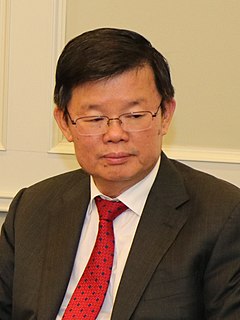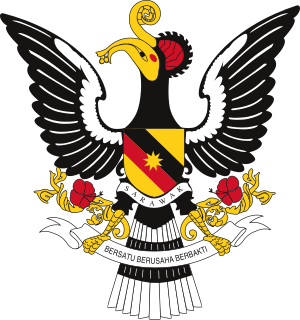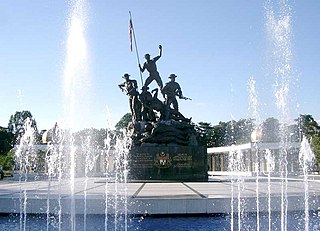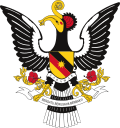
The Yang di-Pertuan Agong, Jawi: يڠدڤرتوان اݢوڠ), also known as the Supreme Head of the Federation, Paramount Ruler or King of Malaysia, is the constitutional monarch and head of state of Malaysia. The office was established in 1957, when the Federation of Malaya gained independence from the United Kingdom. The Yang di-Pertuan Agong is elected by the Conference of Rulers, comprising the nine rulers of the Malay states, with the office de facto rotated between them, making Malaysia one of the world's few elective monarchies.
The Yang di-Pertua Negeri is the official title of the ceremonial governors of the Malaysian states without monarchs, namely Penang, Malacca, Sabah and Sarawak. They are appointed to renewable four-year terms by the Yang di-Pertuan Agong, the federal head of state of Malaysia, after consulting the Chief Minister. A Yang di-Pertua Negeri is entitled to the style Tuan Yang Terutama (T.Y.T.), or in English, His Most Excellency.

The prime minister of Malaysia is the head of government of Malaysia. The prime minister directs the executive branch of the federal government. The Yang di-Pertuan Agong appoints as the prime minister a member of Parliament (MP) who, in his opinion, is most likely to command the confidence of a majority of MPs; this person is usually the leader of the party winning the most seats in a general election.

The Federal Constitution of Malaysia which came into force in 1957, is the supreme law of Malaysia and it contains a total of 183 Articles. It is a written legal document that have been shaped by two previous documents which were the Federation of Malaya Agreement 1948 and the Independence Constitution of 1957. The Federation was initially called the Federation of Malaya and it adopted its present name, Malaysia, when the states of Sabah, Sarawak and Singapore became part of the Federation. The Constitution establishes the Federation as a constitutional monarchy having the Yang di-Pertuan Agong as the Head of State whose roles are largely ceremonial. It provides for the establishment and the organisation of three main branches of the government: the bicameral legislative branch called the Parliament, which consists of the House of Representatives and the Senate ; the executive branch led by the Prime Minister and his Cabinet Ministers and the judicial branch headed by the Federal Court.

The Chief Minister of Penang is the head of government in the Malaysian state of Penang. According to convention, the chief minister is the leader of the majority party or largest coalition party of the Penang State Legislative Assembly. The chief minister's official residence is Seri Teratai in the capital city of George Town.

The Yang di-Pertua Negeri of Sarawak, also known as the Governor of Sarawak, is the ceremonial head of state of the Malaysian state of Sarawak. The Yang di-Pertua Negeri is styled Tuan Yang Terutama.
This article lists important figures and events in Malaysian public affairs during the year 1969, together with births and deaths of notable Malaysians. Race riots following the general election of 10 May led to the dissolution of parliament and an interim legislative council being put in place.

This article lists important figures and events in Malaysian public affairs during the year 1966, together with births and deaths of significant Malaysians.

The Conference of Rulers in Malaysia is a council comprising the nine rulers of the Malay states, and the governors or Yang di-Pertua Negeri of the other four states. It was officially established by Article 38 of the Constitution of Malaysia, and is the only such institution in the world, according to the Malaysian National Library. Its main responsibility is the election of the Yang di-Pertuan Agong (King) and their deputy, the Timbalan Yang di-Pertuan Agong, which occurs every five years or when the positions fall vacant. Although its position in the process of elective monarchy is unique, the Conference of Rulers also plays a role in amending the Constitution of Malaysia and some other policies, in particular, those Articles which have been "entrenched", namely those pertaining to the status of the rulers, the special privileges of the indigenous Bumiputra, the status of the Malay language as the national language, and the clause governing the entrenchment of such Articles.

The Government of Malaysia, officially the Federal Government of Malaysia, is based in the Federal Territory of Putrajaya with the exception of the legislative branch, which is located in Kuala Lumpur. Malaysia is a federation of 11 states of Peninsular Malaysia, Sabah, Sarawak and 3 Federal Territories operating within a constitutional monarchy under the Westminster system and is categorised as a representative democracy. The federal government of Malaysia adheres to and is created by the Federal Constitution of Malaysia, the supreme law of the land.

The Ketua Menteri Sabah or Chief Minister of Sabah is the head of government of the Malaysian state of Sabah. Since September 2020, the position has been held by Hajiji Noor from the Malaysian United Indigenous Party (BERSATU), Perikatan Nasional (PN) from the coalition of Gabungan Rakyat Sabah (GRS) which had won the 2020 Sabah state election. As in other parts of the Malaysian federation, the Westminster Parliamentary system is adopted, whereby, the leader of the party with the most seats in the state legislature would usually become the chief minister of Sabah. In other words, it is the person commanding the support of the state legislature. The chief minister is appointed by the head of state known as the Yang di-Pertua Negeri. In comparison to other states in Malaysia, the office of the Chief Minister of Sabah has been held by a more diverse group of people in terms of ethnicity and religion. The post has been held by Kadazan-Dusuns, Bajaus, Malays, Chinese, Muruts, Rungus, Sungai, Idaans, and other persons of mixed heritage as well as being Muslims, Buddhists and Christians.

The Sarawak State Legislative Assembly is the legislative chamber of the unicameral legislature of the Malaysian state of Sarawak; the Yang di-Pertua Negeri of Sarawak forms the other part of the legislature. The Assembly is modelled after the traditions of the Westminster parliamentary system, which originates from the practices of the British Parliament. The executive branch of government is drawn from the elected members of the Assembly. The State Legislative Assembly sits at the Sarawak State Legislative Assembly Building located in Petra Jaya in Kuching, the state capital.

The Ketua Menteri Melaka or Chief Minister of Malacca is the head of government in the Malaysian state of Malacca. According to convention, the Chief Minister is the leader of the majority party or largest coalition party of the Malacca State Legislative Assembly. The post is currently held by Sulaiman Md Ali, who took office on 9 March 2020.

The Menteri Besar of Negeri Sembilan or First Minister of Negeri Sembilan is the head of government in the Malaysian state of Negeri Sembilan. According to the convention, the Menteri Besar is the leader of the majority party or largest coalition party of the Negeri Sembilan State Legislative Assembly.
The state governments in Malaysia are the governments ruling the 13 states in the federation of Malaysia. All 13 states adopts the Westminster Parliamentary system and each has a unicameral state legislative assembly. Each state of Malaya is run by an EXCO, while Sabah and Sarawak have their respective Cabinet and Ministry. The state government structure in all 13 states is similar to the government system of the federal government of Malaysia and that the state legislatures consist of only a single chamber.

The Malaysia Bill is an annex of the Agreement relating to Malaysia between United Kingdom of Great Britain and Northern Ireland, Federation of Malaya, North Borneo, Sarawak and Singapore. It gave effect to the Agreement where that the British colonies of North Borneo, Sarawak and the State of Singapore should be federated with the existing States of the Federation of Malaya and the name of the federation should be Malaysia, and the Federal constitution wherewith to amend and adopt the Constitution of the Federation of Malaya so as to provide for the admission of those States. it adopted its present name, the name of the Constitution of the Federation of Malaya should be changed into Constitution of Malaysia.

The Governor of Sabah is the ceremonial head of state of the Malaysian state of Sabah. Other meaning is "His Excellency" Governor of Sabah. The Yang di-Pertua Negeri is styled Tuan Yang Terutama (TYT).
The Sabah State Government is an authority governing Sabah, one of Borneo states of Malaysia, based in Kota Kinabalu, the state capital. The state government adheres to and is created by both the Federal Constitution of Malaysia, the supreme law of Malaysia, and the Constitution of the State of Sabah, the supreme law of the State.
The Sarawak Government is an authority governing Sarawak, one of the Borneo states of Malaysia, based in Kuching, the state capital. The state government adheres to and is created by both the Federal Constitution of Malaysia, the supreme law of Malaysia, and the Constitution of the State of Sarawak, the supreme law of the State.
Rosey binti Haji Yunus is a Malaysian politician from the Parti Pesaka Bumiputera Bersatu (PBB), a component party of the ruling Gabungan Parti Sarawak (GPS) coalition who has served as the State Assistant Minister of Women, Family, Welfare, Community Wellbeing and Childhood Development of Sarawak in charge of Women, Family and Childhood Development in the Barisan Nasional (BN) and GPS state administrations under Chief Ministers Abdul Taib Mahmud, Adenan Satem and Abang Abdul Rahman Johari Abang Openg as well as Minister Fatimah Abdullah since September 2011 and Member of the Sarawak State Legislative Assembly (MLA) for Bekenu since May 2006.




















